PREVIOUS
India Employment Report 2024 - Part 04
India Employment Report 2024 - Part 04
(இதன் தமிழ் வடிவத்திற்கு இங்கே சொடுக்கவும்)
Migration Trends in India (2000–2021)
- Understanding employment patterns and growth necessitates examining migration trends, particularly those related to employment.
Key Trends:
- Overall Migration Rate: The overall migration rate in India increased slightly by 2.1 percentage points, from 26.8% in 2000 to 28.9% in 2021.
Gender Disparities:
- Women: The migration rate among women rose significantly, increasing by 5.5 percentage points from 42.4% to 47.9%.
- Men: Conversely, the migration rate for men declined by 1.4 percentage points, falling from 12.1% to 10.7%.
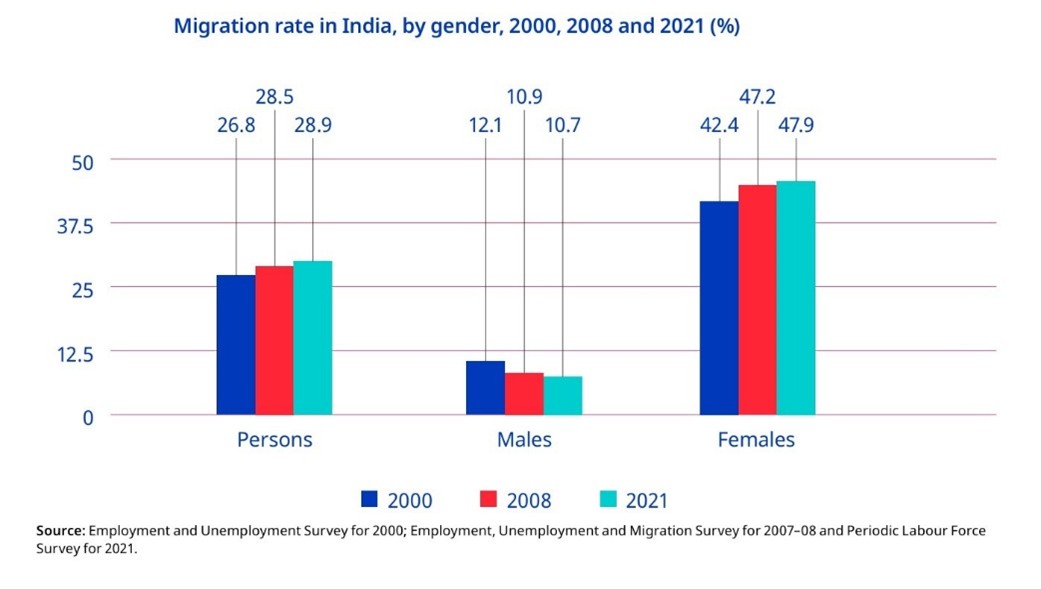
Migration Due to Employment-Related Reasons
- Overview
- In 2021, about 10.7% of all migrants migrated for employment purposes.
- Reasons for Migration
- Searching for employment.
- Better employment opportunities.
- Transfer.
- Proximity to place of work.
- Lack of employment opportunities in previous place of residence.
- Gender Disparities
- Women: 1.7% of female migrants.
- Men: 49.6% of male migrants.
- Regional Highlights
- Delhi: 87.1%
- Karnataka: 63.2%
- Maharashtra: 59.5%
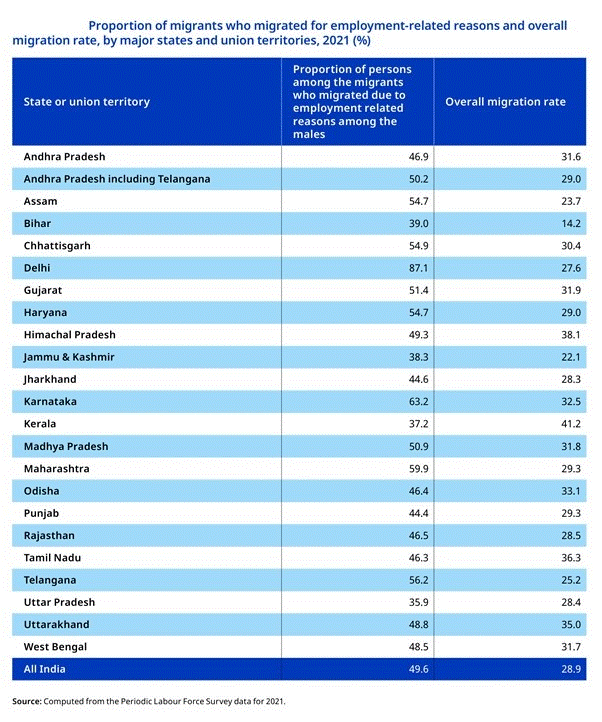
Changes in Employment Categories
- Self-Employment
- Consistent Increase: The number of workers in self-employment rose steadily during the pandemic years and continued into 2022.
- Vulnerable Work: This growth was particularly noted in unpaid family work in rural areas and among women.
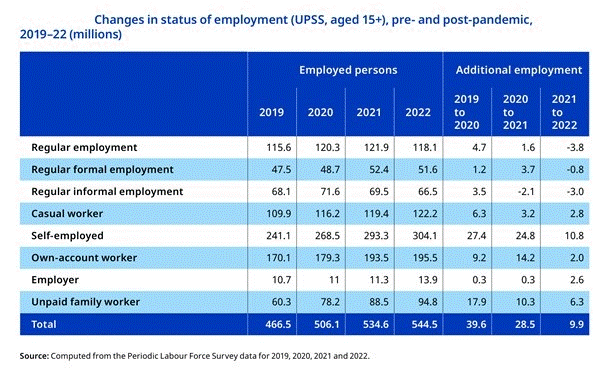
Proportion of Workforce:
- Composition: A significant portion of self-employed individuals consisted of unpaid family workers.
Regular and Casual Employment
- Slow Growth: The number of people engaged in regular formal, informal, and casual employment increased at a slower pace during the pandemic.
- Casual Employment: Showed some resilience, with continued growth compared to other forms of employment.
- Decline Post-Pandemic: After the pandemic, regular and informal employment numbers declined, while casual employment held steady.
Geographic Distribution
- Rural: More than three-fourths of the additional self-employed individuals were in rural areas.
Changes in Real Monthly Wages and Earnings
- Overview
- The impact of COVID-19 on wages was significant during the peak pandemic years, with some recovery noted in 2022.
- Casual Wages
- 2020: Casual wages grew slowly, affected by lockdown measures.
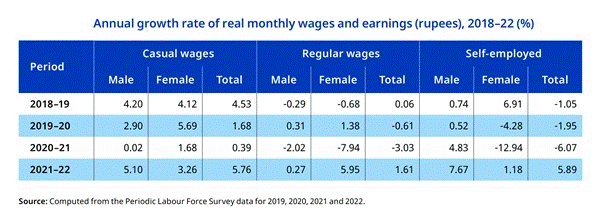
- 2021: Growth remained negligible.
- 2022: A revival in the growth rate of casual wages was observed during the recovery period.
Regular and Self-Employed Earnings
- Low Growth Rates: Both regular and self-employed earnings showed low or negative growth rates up to 2021.
- 2022 Recovery: Growth in both categories was noted during 2022.
Gender Disparities in Wage Growth
- Regular Wages: Both female and male workers experienced a slight negative growth rate in regular wages from 2018 to 2022.
- Self-Employed Earnings: Female self-employed workers faced a significantly higher negative growth rate in earnings compared to their male counterparts.
- Casual Wages: Women’s casual wages exhibited a slightly higher growth rate compared to men’s casual wages.
- These trends underscore the varying impacts of the pandemic on different employment types and highlight persistent gender disparities in earnings.
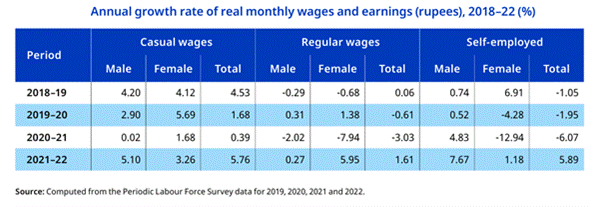
Sectoral Employment Analysis (2019–2022)
- Overview
- The broad sectoral analysis indicates varying trends in employment across different sectors between 2019 and 2022.
Sector-Specific Employment Trends
- Agriculture and Allied Sectors
- Consistent Growth: The agriculture sector saw a significant increase in employment, with increases of 30.8 million in 2020, 12.1 million in 2021, and 12.9 million in 2022.
- Construction Sector
- Steady Increase: Employment in the construction sector also showed consistent growth, with increases of 2.4 million in 2020, 5.7 million in 2021, and 3.3 million in 2022.
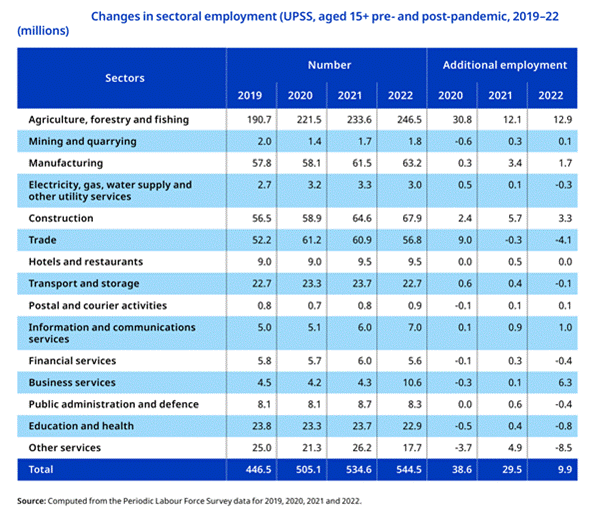
Other Sectors
- Stability or Minor Increase: The number of people had engaged in construction, trade, manufacturing, and information and communication services either remained stable or saw a small increase during the same period.
Impact of Lockdowns
- Job Losses During Lockdown: Quarterly data reveal job losses in the manufacturing, construction, trade, hotels, restaurants, and some areas of the agriculture sector during the nationwide lockdown.
- Post-Lockdown Recovery: Following the lifting of lockdown measures, there was a significant increase in employment in both the agriculture and construction sectors, reflecting the annual sectoral changes during the pandemic.
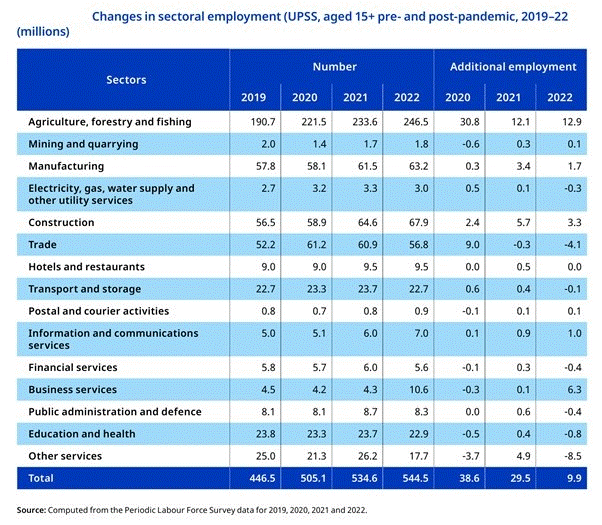
Technological Advancement and Employment Trends
- Overview of Employment Shifts (2000-2019)
- In 2000, high- and medium-skill jobs were at 5.1%. By 2019, this increased to 9.6%.
- Low-skill jobs rose from 60.5% in 2000 to 65.1% in 2019.
- No-skill jobs decreased from 34.4% in 2000 to 25.4% in 2019.
Shift in Employment Trends (2019-2022)
- Increase in Low-Skill Jobs.
- Continuing upward trend in low-skill job availability.
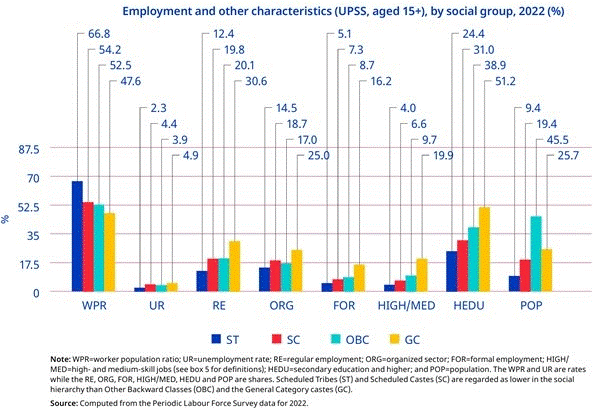
Decrease in High- and Medium-Skill Jobs
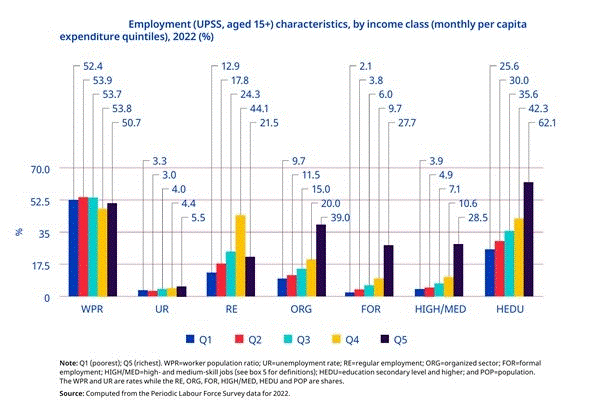
- Notable decline observed in high- and medium-skill job opportunities.
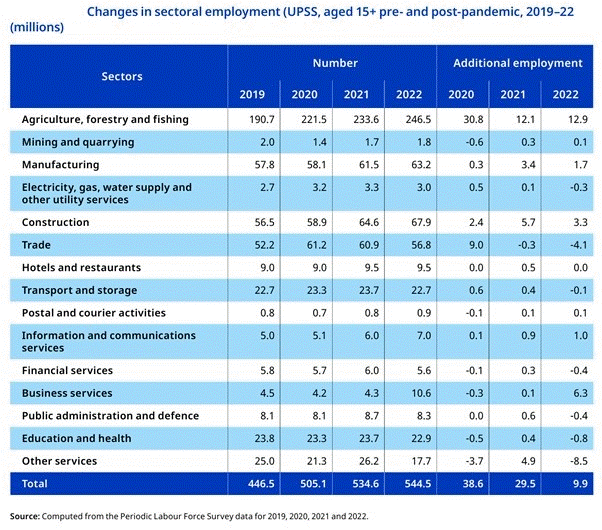
Impact of COVID-19 on Employment Quality
- Job Loss and Quality of Employment
- The pandemic caused significant job losses for regular salaried workers.
- Quality of employment was adversely affected, leading to economic strain on households.
- Financial Strain
- Families were pressured to start their own businesses.
- Involvement of family members in unpaid work increased.
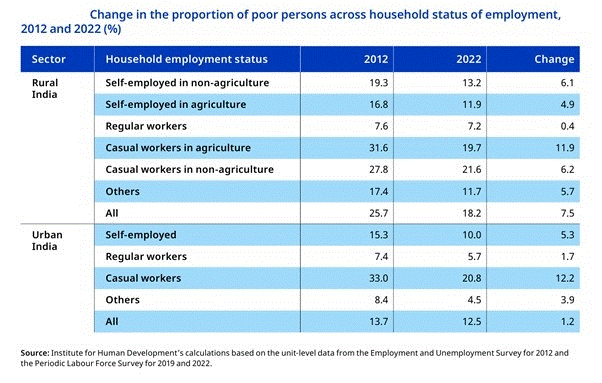
Employment Trends (2000-2019)
- Increase in High- and Medium-Skill Jobs
- Share rose from 5.1% in 2000 to 9.6% in 2019.
- Increase in Low-Skill Jobs
- Share increased from 60.5% in 2000 to 65.1% in 2019.
- Decrease in No-Skill Jobs
- Share fell from 34.4% in 2000 to 25.4% in 2019.
Shift in Employment Trends (2019-2022)
- Increase in Low-Skill Jobs
- Continued rise in low-skill job availability.
- Decrease in High- and Medium-Skill Jobs
- Notable decline in high- and medium-skill job opportunities.
Labor Market Dynamics
- Sustained Increase in Low-Skilled Labor Supply
- Many individuals compelled to work to support family income.
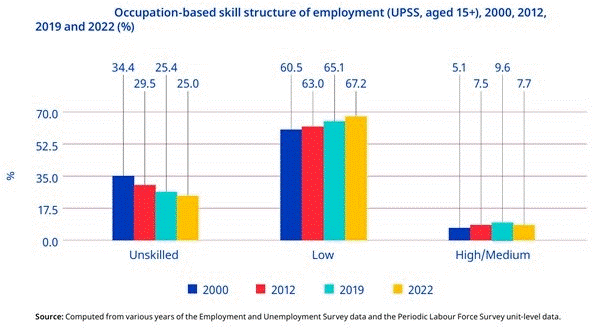
Employment Trends in the Manufacturing Sector
- Increase in High- and Medium-Skill Jobs
- The share of high- and medium-skill jobs rose from 2.9% to 6.7% between 2000 and 2022.
- Increase in No-Skill Jobs
- The share of no-skill jobs increased from 9.7% to 20.4% during the same period.
Variability Among Enterprises
- Not all enterprises experienced these trends equally.
- In the Indian manufacturing sector, over 90% of enterprises are micro, small, and informal.
- These enterprises predominantly rely on manual and unskilled labor.
Sector-Specific Observations
- The trend of increasing high- and medium-skill jobs was more pronounced in formal, capital intensive, and modern manufacturing sectors.
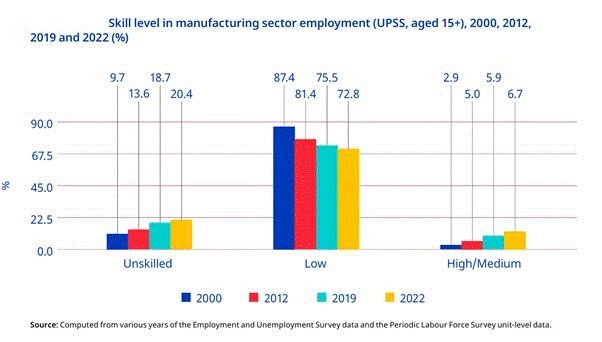
Employment Trends in the Services Sector
- High- and Medium-Skill Jobs Distribution
- Public Administration, Health, and Education: 45.1%
- Financial, Business, and Real Estate: 42.3%
- Transport, Storage, and Communication: 19.7%
- Trade, Hotels, and Restaurants: 3%
Low- and No-Skill Jobs Distribution
- Trade, Hotels, and Restaurants:
- Predominantly low- and no-skill jobs, making up 97% of employment in this category.
Growth in High- and Medium-Skill Jobs
- Transport, Storage, and Communication:
- Share of high- and medium-skill jobs increased from 2.7% in 2000 to 19.7% in 2022.
- This growth includes jobs related to information and communication technology (ICT).
Impact of COVID-19 on ICT Employment
- The demand for high- and medium-skilled ICT workers accelerated during and after the COVID-19 pandemic.
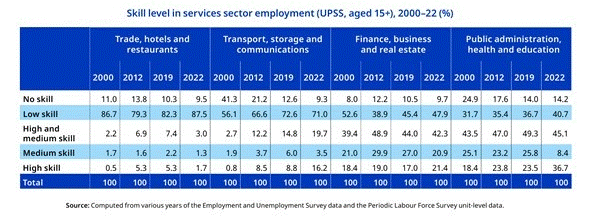
Impact of Technological Changes on Employment
- Employment Trends Over Two Decades
- Shift in Labor Demand:
- Increase in employment of highly skilled labor.
- Reduction in low-skilled labor employment in manufacturing and services sectors.
- Medium-Skill Employment Stability:
- Unlike in developed economies, technological advancements in India have not resulted in decrease in medium-skilled labor employment in absolute terms.
Robotization in India
- Current Robotization Rate:
- Very low, accounting for only 0.8% of global robots, with 4,945 industrial robots reported in 2021.
- Concentration of Robotization:
- Primarily limited to capital-intensive industries and medium- to large-sized service units.
- Impact on Low-Skilled Labor:
- Robot usage is restricted to a few tasks, resulting in a low likelihood of displacing low-skilled and unskilled labor in the near future.
Sectoral Trends:
- Subsequent sections will delve deeper into broad sectoral trends, further examining the
- dynamics of growth, productivity, and employment relationships.

Demographic Structure of India (2011-2036)
- Overview of the Working-Age Population
- Current and Future Projections: This section analyses the demographic structure of India,
- focusing on projections from 2011 to 2036 to understand the working-age population dynamics.
- Changing Population Trends: Examination of shifts in child, youth, adult, and older person
- populations to assess the evolution of India's labor force and dependency ratio.
Demographic Dividend
- Working-Age Population Advantage:
- A significant proportion of India’s population is in the working age (15-59 years), expected to
- remain within this demographic dividend zone for at least another decade.
- This demographic structure enables greater participation in productive work, enhancing national income.
Population Growth Projections
- Population Estimates:
- India’s population is projected to grow from 1.36 billion in 2021 to 1.48 billion by 2031, and
- further to 1.52 billion by 2036.
Trends in Birth and Death Rates
- Decline in Rates: Over the past two decades, India has seen a continuous decline in crude birth and death rates, leading to the lowest population growth rate since Independence.
- Decadal Growth Rates:
- The decadal growth rate from 2011 to 2021 was 12.5%, with a projected decline to 8.4% for the 2021-2031 decade.
Working-Age Population Proportion
- Growth in Proportion:
- The proportion of the working-age population increased from 61% in 2011 to 64% in 2021, with projections suggesting it will reach 65% by 2036, stabilizing thereafter.
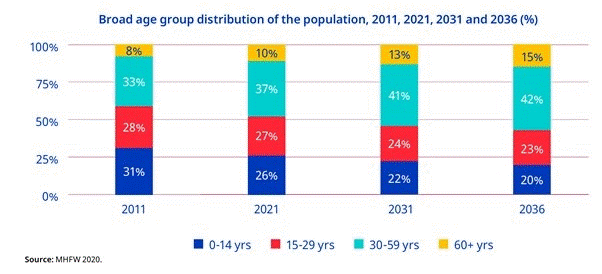
Regional Demographic Changes in India
- Disparities in Youth Employment Trends
- Significant regional variability exists in youth employment and unemployment trends.
- These disparities affect the ability to create decent jobs and realize the demographic dividend
- effectively.
- Age Structure and Economic Development
- The status and pace of population aging differ across regions.
- Variations in age structure and levels of employment and economic development influence these differences.
Key States with Youth Population
- Uttar Pradesh and Bihar:
- These states have the largest share of youths in the population.
- Their youth populations are expected to grow by 2036.
- Other Notable States:
- Maharashtra, Madhya Pradesh, and Rajasthan will also contribute significantly to India’s youth population.
- The youth population is projected to rise from 49.2% in 2021 to around 51.5% by 2036.
Regional Variations in Youth Population
- Eastern, Central, and Northern States:
- States like Bihar, Jharkhand, Chhattisgarh, Rajasthan, Madhya Pradesh, and Uttar Pradesh have substantial youth and working-age populations.
- Southern States:
- Tamil Nadu, Kerala, Andhra Pradesh, and Karnataka have smaller youth populations.
- These populations are expected to decline further.
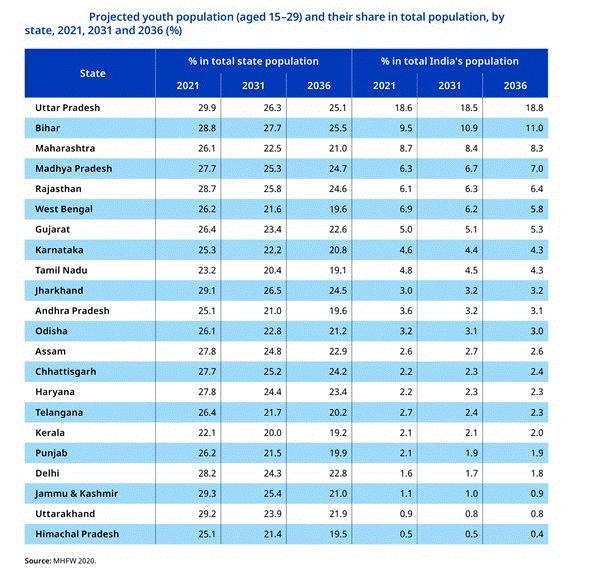
- In conclusion, overcoming the complex challenges in India's labor market calls for a comprehensive and strategic policy framework.
- By focusing on employment creation, job quality, equality, skills training, and knowledge enhancement, India can better navigate its demographic transitions and ensure a more inclusive and productive workforce for the future.
-------------------------------------


